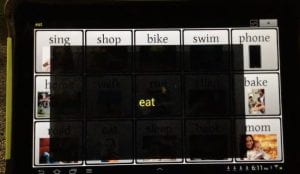 Caron, J., Light, J., Holyfield, C., & McNaughton, D. (2018). Effects of dynamic text in an AAC app on sight word reading for individuals with autism spectrum disorder. Augmentative and Alternative Communication, 34, 143-154
Caron, J., Light, J., Holyfield, C., & McNaughton, D. (2018). Effects of dynamic text in an AAC app on sight word reading for individuals with autism spectrum disorder. Augmentative and Alternative Communication, 34, 143-154
Submitted to the NARIC database
Free re-prints may be available at https://rerc-aac.psu.edu/free-eprints-available/
Abstract
The purpose of this study was to investigate the effects of Transition to Literacy (T2L) software features (i.e., dynamic text and speech output upon selection of a graphic symbol) within a grid display in an augmentative and alternative communication (AAC) app, on the sight word reading skills of individuals with autism spectrum disorders (ASD) and complex communication needs. The study implemented a single-subject multiple probe research design across one set of three participants. The same design was utilized with an additional set of two participants. As part of the intervention, the participants were exposed to an AAC app with the T2L features during a highly structured matching task. With only limited exposure to the features, the five participants all demonstrated increased accuracy of identification of 12 targeted sight words. This study provides preliminary evidence that redesigning AAC apps to include the provision of dynamic text combined with speech output, can positively impact the sight-word reading of participants during a structured task. This adaptation in AAC system design could be used to complement literacy instruction and to potentially infuse components of literacy learning into daily communication.
The purpose of this study was to investigate the effects of Transition to Literacy (T2L) software features (i.e., dynamic text and speech output upon selection of a graphic symbol) within a grid display in an augmentative and alternative communication (AAC) app, on the sight word reading skills of individuals with autism spectrum disorders (ASD) and complex communication needs. The study implemented a single-subject multiple probe research design across one set of three participants. The same design was utilized with an additional set of two participants. As part of the intervention, the participants were exposed to an AAC app with the T2L features during a highly structured matching task. With only limited exposure to the features, the five participants all demonstrated increased accuracy of identification of 12 targeted sight words. This study provides preliminary evidence that redesigning AAC apps to include the provision of dynamic text combined with speech output, can positively impact the sight-word reading of participants during a structured task. This adaptation in AAC system design could be used to complement literacy instruction and to potentially infuse components of literacy learning into daily communication.
